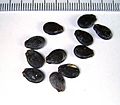Watermelon seed oil facts for kids
Watermelon seed oil is made by pressing the seeds of the watermelon plant. You might hear it called ootanga oil in West Africa, where it's very common.
Contents
What is Watermelon Seed Oil?
Watermelon seed oil is a natural oil taken from the tiny seeds inside watermelons. People get this oil by pressing the dried seeds. It's used for different things, like in cooking or in skin products.
Where Do Watermelons Come From?
Watermelons first grew almost 5,000 years ago in the Kalahari Desert in Africa. The wild plant, called the Kalahari Melon, still grows there today. People in that area have been pressing its seeds for oil for a very long time. Over many years, watermelons traveled north through Egypt. By the time of the ancient Romans, watermelons were grown and loved by many.
How Watermelon Seed Oil is Made
Just like their wild relatives, the seeds from the watermelons we eat today can be pressed to make oil. First, the seeds are taken out of the watermelon fruit. Then, they are left to dry in the sun. Once the seeds are completely dry, they are put into a special machine that presses them to squeeze out the oil.
What's Inside Watermelon Seed Oil?
Watermelon seed oil has a lot of good fats called unsaturated fatty acids. The two main types are linoleic acid and oleic acid. These are important fats that can be good for you. For example, linoleic acid makes up most of the oil, about 63%. Oleic acid is also a big part, around 15%.
| Fatty Acid | Percent |
|---|---|
| Palmitic acid (C16:0) | 11.0 |
| Stearic acid (C18:0) | 10.0 |
| Oleic acid (C18:1) | 15.0 |
| Linoleic acid (C18:2) | 63.0 |
| Refractive Index (40ºC) | 1.4630-1.4670 |
| Iodine value | 115-125 |
| Saponification value | 190-198 |
| Unsaponifiable matter | 1.5% max |
| Moisture | 0.5% max |
| Colour 1/2" cell (y+5R) | 20.0 units |
Images for kids






